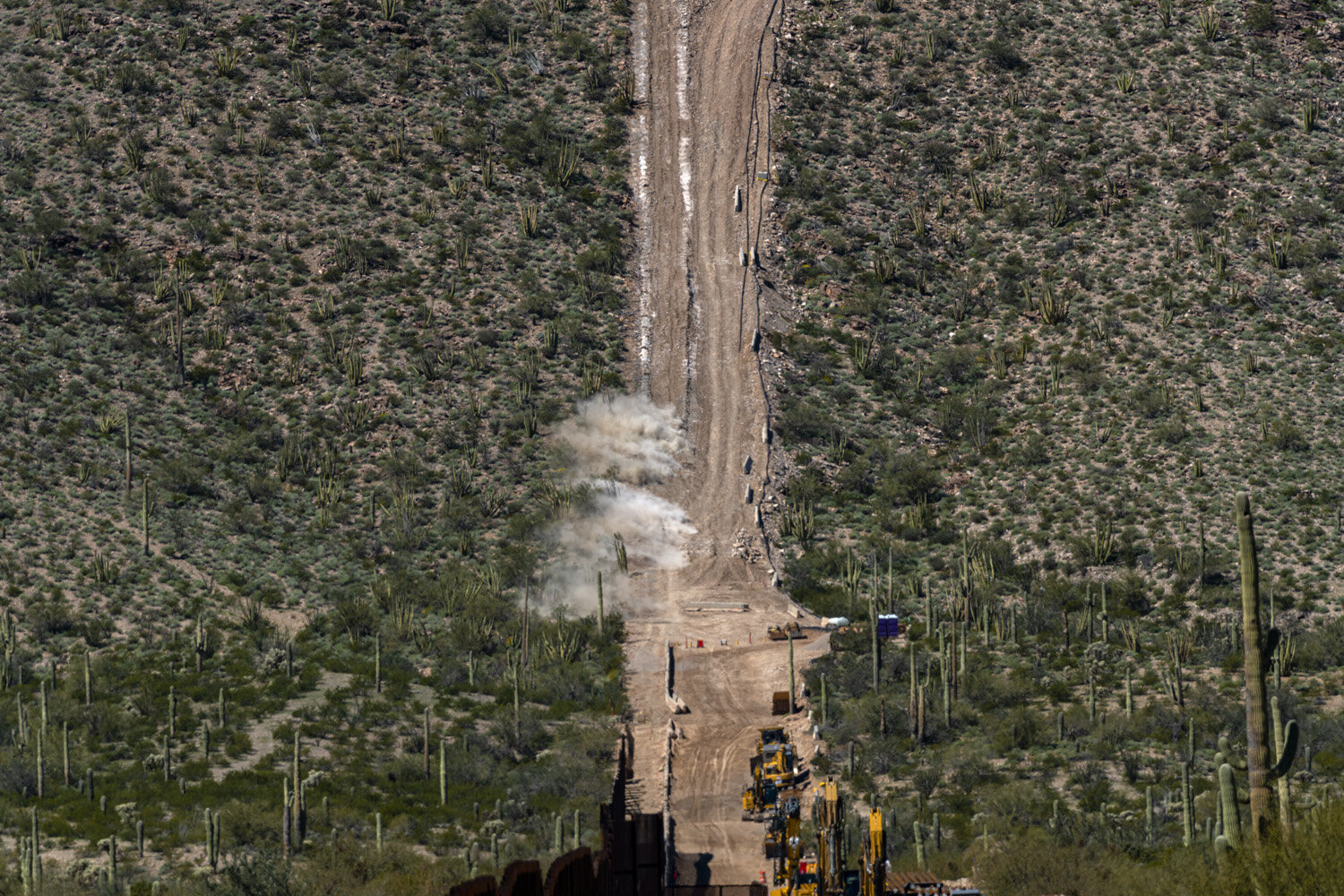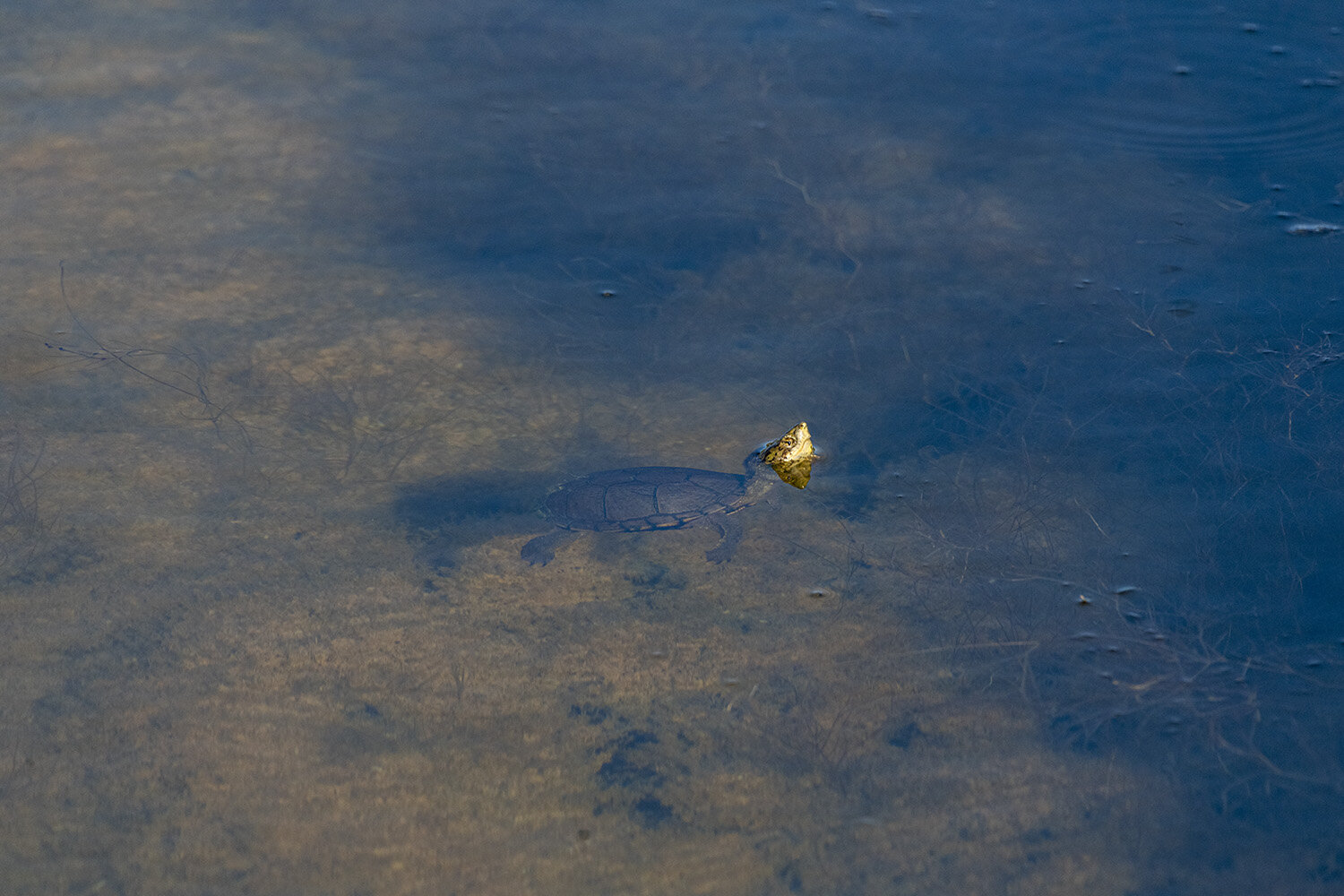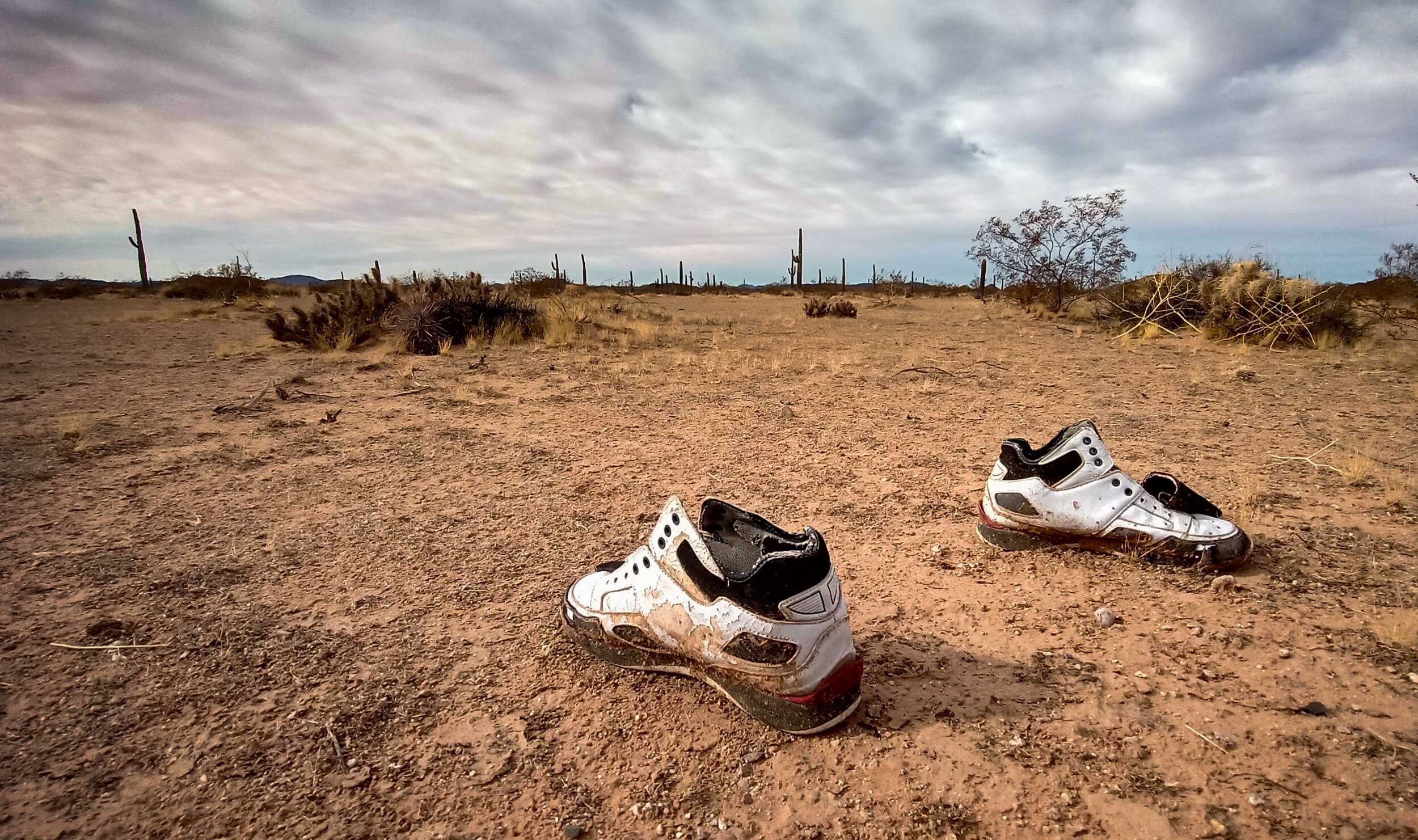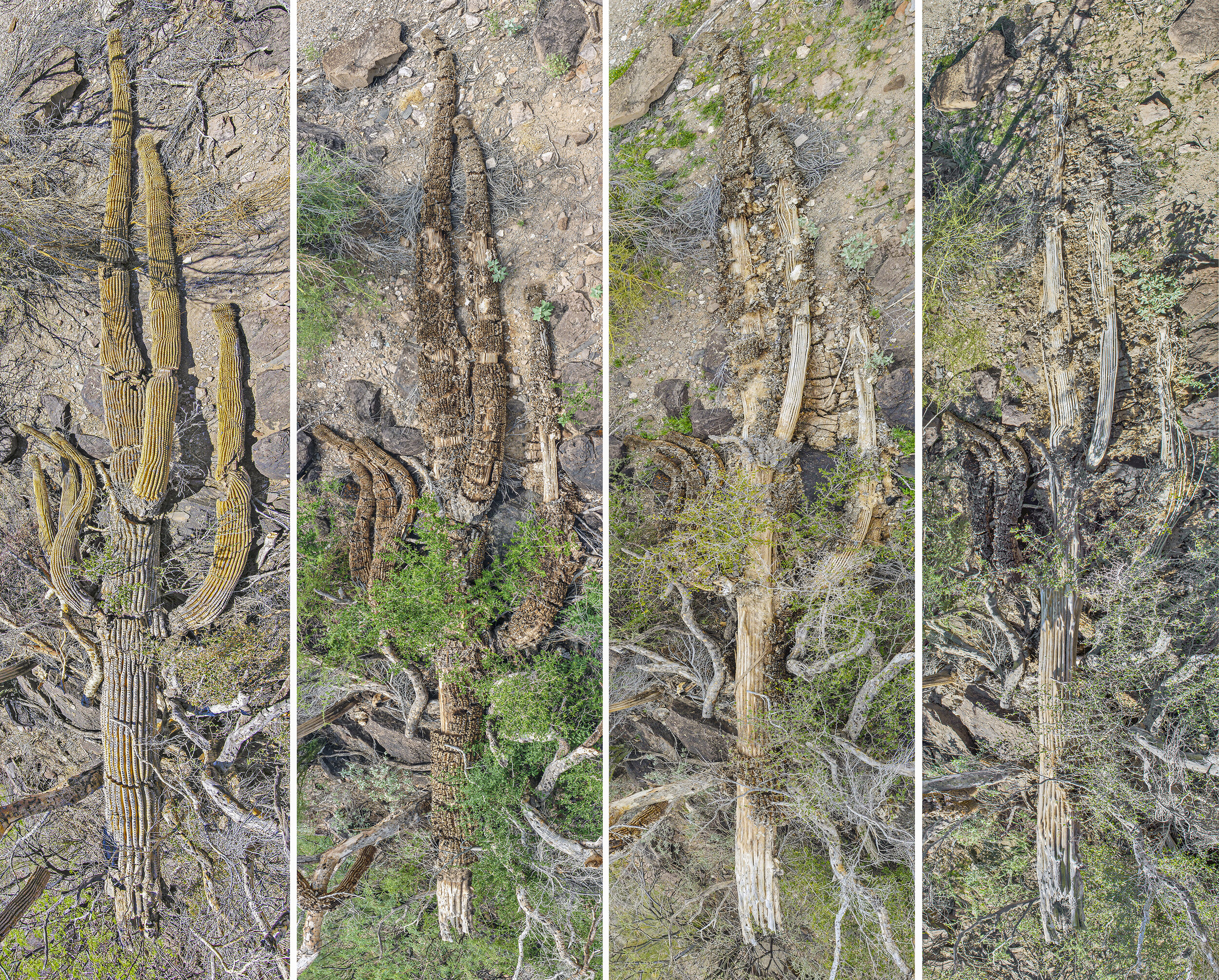Devastation: Restoring Life and Land at the Border
Photography, video and paintings by: Patrick Donnelly, Miguel Grageda, Laiken Jordahl, John Kurc, Susan Lyman, Jake Meyers, Paul Mirocha, Ash Ponders and Bob Torrez.
— Online: JULY 15th - SEPTEMBER 2021
Introduction
— Laiken Jordahl, Center for Biological Diversity
On a hot February day last year, I watched the Department of Homeland Security blow up a mountain in a stunning desert wilderness area where I used to work. Nine-hundred pounds of dynamite sent shockwaves rippling up a cactus-studded hillside at Organ Pipe Cactus National Monument, turning ancient granite and rugged cliff faces into dust. Saguaro arms shook as clouds of smoke and earth rose into the sky. As the dust settled, an O’odham friend, whose relatives have sustained themselves from this very desert for thousands of years, fell to her knees and wept. She said she could feel her ancestors’ spirits being released from the earth.
Watching the U.S. Government blow up a mountain home to Indigenous gravesites in a national park unit still seems unthinkable, especially to a former National Park Service employee like me. But atrocities like this have happened across the Arizona-Sonora borderlands, as federal contractors demolished Indigenous sacred sites, bulldozed wildlife refuges, and sealed off migration corridors for endangered jaguars, Mexican wolves and other wildlife with a hulking 30-ft border wall.
It’s been more than a year since we watched the hillside at Organ Pipe crumble and a new president has vowed to stop building the wall. As the dust finally settles, as the bulldozers and construction crews pack up and leave, we turn now to face the mangled, open wounds of the land. Despite dozens of lawsuits, formal warnings from federal wildlife agencies, numerous protests and the arrests of fourteen Indigenous land defenders, more than 200 miles of wall have gone up across Arizona. Access roads wide enough to land an airplane on have plowed through the most pristine and rugged corners of the Sonoran Desert. Miraculous rivers like the San Pedro, a life-giving ribbon of green that sustains millions of migratory birds, have been filled in with gravel and dammed by a mass of metal. Hundreds of ancient saguaro cactuses—many of them older than the border itself—have been toppled by bulldozers to make way for the wall.
These photographs tell the story of this immense loss, of decay and destruction, of a land sacrificed for political gain. We urge you to look closely. To feel the weight of these images and to ponder all that we’ve done to this land. Grieve with us. We can’t carry this weight alone. Soon enough, we’ll tear the wall down.
Exhibition Galleries
Click on the images below to view the galleries.
Selected Artists
Patrick Donnelly — Nevada State Director of the Center for Biological Diversity, works to defend the wildlife and wild places of Nevada, with a focus on endemic species and groundwater resources. Patrick spent over a decade leading young people in hands-on conservation work and on extended outdoor education trips. He has led campaigns to protect national monuments, stop inappropriate energy development, and prevent overappropriation of scarce desert water. Patrick has a bachelor's in environmental science and policy from the University of California Berkeley.
Miguel Grageda — A researcher and conservation photographer. Currently, a doctoral candidate at the School of Natural Resources and the Environment at the University of Arizona. Has had the opportunity to photograph and document the biodiversity of different ecosystems in North America. HIs work as researcher led him to discover fascinating places from the arid Chihuahuan and Sonoran deserts, to the humid rain forest of the Yucatan peninsula. His goal is to communicate with images, information and stories the urgent necessity to conserve our natural resources. en.miguelgragenda.com
Laiken Jordahl — Borderlands Campaigner, works to protect wildlife, ecosystems and communities throughout the U.S.-Mexico borderlands and draw attention to the costs of border wall construction and border militarization. Before joining the Center, Laiken worked with the National Park Service studying threats to wilderness character throughout the Rocky Mountain West, including Big Bend National Park and Organ Pipe National Monument. He has also worked as a legislative fellow in the U.S. House of Representatives and for two Arizona congressional representatives. https://twitter.com/LaikenJordahl
John Kurc — As a wedding and concert photographer, John Kurc was shooting the Rolling Stones in Phoenix, Arizona in the summer of 2019 when he took a detour to the US/Mexico border to have lunch. There, John was shocked by what he saw. After COVID abruptly ended his photography business, and motivated by what he had witnessed on the border that day, he decided to turn towards making a difference with his camera. He returned to Southern Arizona and began investigating and documenting the construction of the Trump border wall. Beyond the pulverized desert landscape and horrific impact on wildlife migration, John has also found a web of international crimes, illegal mishandling of billions of taxpayer dollars, families being separated across the border, and inhumane treatment of immigrants. John believes that even if the border construction stops with the new administration, the work in bringing these crimes to justice has just begun.
Susan Lyman — Working both as a painter and in wood as a sculptor, my work has long been inspired by the landscape and natural forms of the three habitats where I spend my time: Michigan’s northern woods, Outer Cape Cod’s coastal environment, and Arizona’s Sonoran Desert. However, in the last several years my view of landscape as a subject has shifted. I have felt increasingly compelled to express the sorrow and loss I feel over man’s destruction of and disregard for this planet earth that we share with all humankind and all forms of life. www.susanlyman.com
Jake Meyers — an international development practitioner and emergency management professional with a passion for using storytelling as a tool for building resilience. Originally from Pennsylvania, Jake earned his Master's in Development Practice from the University of Arizona where he engaged with the border crisis. As a correspondent with Planet Forward, Jake documented the border crisis in the hopes of sharing with others the realities of what is happening on the ground. Jake is currently a Continuous Improvement Advisor with FEMA. He previously served as a Peace Corps Volunteer in Benin and was awarded a Fulbright research fellowship in Cambodia where he developed his love for storytelling as a tool of cross-cultural exchange.
Paul Mirocha — A versatile designer with decades of experience and strong visual skills in graphic design, web design, digital illustration, and digital imaging. An artist in residence at the University of Arizona since 2011. Creative and inventive, a keen observer and researcher sees new possibilities and alternatives; a self-directed learner, empathetic and a good communicator.
Ash Ponders — Panamanian tisoy multimedia artist Ash Ponders (b. 1986) lives in the Sonoran Desert making visuals rooted in the history of both the environment and the people that live there for newspapers and art galleries. Their art has been covered by the New York Times, BBC, CNN and Teen Vogue. Their journalism has been commissioned by NYT, National Geographic, WSJ, WaPo, San Francisco Chronicle, The Intercept, NPR, PRI, PBS, HCN, Smithsonian, Audubon and La Prensa. Ponders is a member of NAHJ, NPPA, FFR, Diversify Photo and Juntos Photo Coop. They're also an award-winning poet and translator. They desperately want you to follow them on instagram.
Bob Torrez — A photographer who has been documenting the Southern Arizona boarder for seven years. His work has appeared in the NYTimes, the University of Arizona Archives, the Guardian with stock images provided to Zuma Press and Alamy News. His photography has been used by the organizations No More Deaths, The Samaritans, Humane Borders, Border Action Network, and The Arizona Palestine Solidarity Alliance. Recently his photography was included in “The Lens on the Border Show,” hosted by the Sierra Club.
Get Involved!
To learn more or to contribute to significant related causes, please visit the following organizations.





